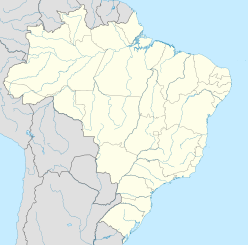Colônia crater
| Colônia crater | |
|---|---|
 2017 Landsat image of Colônia crater | |
| Impact crater/structure | |
| Confidence | Confirmed |
| Diameter | 3.6 km (2.2 mi) |
| Age | 5 to 36 Ma Neogene |
| Exposed | Yes |
| Drilled | Yes |
| Location | |
| Coordinates | 23°52′15″S 46°42′30″W / 23.87083°S 46.70833°W |
| Country | Brazil |
| State | São Paulo |
| District | Parelheiros |
| Municipality | São Paulo |
The Colônia crater is a recently confirmed
São Paulo, Brazil.[1] It is a round bowl-shaped depression, without any obvious central bulge, with a diameter of about 3.6 kilometres (2.2 mi), bounded by a circular ring of hills about 125 metres (410 ft) high relative to the inner depression. Its approximate location is 23°52′15″ South and 46°42′30″ West, 770 metres (2,530 ft) above sea level.[2] The name comes from the town district of Colônia
located just north of the feature.
Geology and ecology
Some geologists believe that the feature was created by the impact of a
South American impact craters known. It is partially filled by peat with maximum depth of 275 metres (902 ft),[3] which provides a precious record of ancient environment. The upper 8 metres (26 ft), in particular, have provided a detailed climate and ecological record of the last 130,000 years; the complete record may stretch back to 2.5 million years ago.[3]
Data from seismic and other surveys indicate that below the sediment there are about 50 to 65 metres (164 to 213 ft) of fragmented rock deposits, and another 50 m of shocked or deformed basement rock. Sediment analysis indicate that until 18,000 years ago a lake occupied the central part of the crater, which has become a swamp.[2] The crater is drained towards the east by the Vargem Grande creek into the adjacent Billings Reservoir.[3]
The tentative identification as an impact crater is based mainly on
faulting pattern, and on the exclusion of other possible formation mechanisms. In particular, there are no carbonate rocks that could produce to karstic sinkholes. As of 2011 there were no reports of definite evidence, such as shatter cones or shocked quartz. To find such evidence one would have to drill through the sediment fill.[2][3]
Urbanization and legal status
The Colônia crater is located in the suburban
CONDEPHAAT. Its southern part was incorporated to the Capivari Monos Municipal Parkland in 1996.[2]
See also
- List of impact craters on Earth
References
- ^ a b "Colonia". Earth Impact Database. Planetary and Space Science Centre University of New Brunswick Fredericton. Retrieved 2020-02-13.
- ^ a b c d e Paulo Gomes Varella (2009) A CRATERA DE COLÔNIA (in Portuguese).
- ^ a b c d e Cláudio Riccomini, Álvaro Crósta, Marie-Pierre Ledru, Renato Luis Prado, Bruno Turq, Lucy Sant'Anna, José Ferrari, and Wolf Reimold (2011), The Colônia structure, São Paulo, Brazil. Meteoritic & Planetary Science, to appear
Further reading
- C. Riccomini, F.A.P.S. Neves, B. Turcq (1992), Astroblema de Colônia (São Paulo, Brasil): Estágio atual de conhecimento. 37º Congresso Brasileiro de Geologia, Sociedade Brasileira de Geologia.



